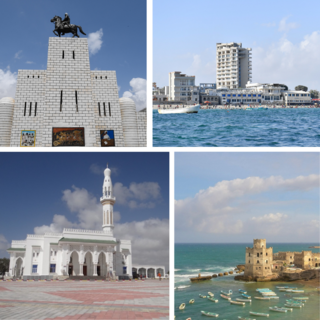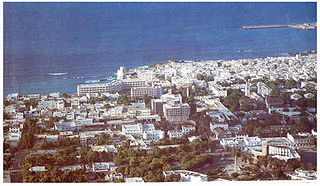Related Research Articles
Somalia, officially the Federal Republic of Somalia and formerly known as the Somali Democratic Republic, is a country located in the Horn of Africa. The country was an important centre for commerce with the rest of the ancient world, and according to most scholars, it is among the most probable locations of the fabled ancient Land of Punt. During the Middle Ages, several powerful Somali states and port towns dominated the regional trade, the Mogadishu Sultanate and Ajuran Sultanate both centered around the port town Mogadishu, but also the port towns of Barawe and Merca.

Mogadishu (, also ; Somali: Muqdisho[mʉq'dɪ:ʃɔ] or Xamar[ħɑmɑr]; Arabic: مقديشو, locally known as Xamar or Hamar, is the capital and most populous city of Somalia. The city has served as an important port connecting traders across the Indian Ocean for millennia, and has an estimated urban population of 4,249,083. Mogadishu is located in the coastal Banadir region on the Indian Ocean, which unlike other Somali regions, is considered a municipality rather than a maamul goboleed.

The Horn of Africa (HoA), also known as the Somali Peninsula, is a large peninsula and geopolitical region in East Africa. Located on the easternmost part of the African mainland, it is the fourth largest peninsula in the world. It is composed of Ethiopia, Eritrea, Somalia and Djibouti; broader definitions also include parts or all of Kenya, Sudan, South Sudan, and Uganda. The term Greater Horn Region (GHR) can additionally include Burundi, Rwanda, and Tanzania. It lies along the southern boundary of the Red Sea and extends hundreds of kilometres into the Guardafui Channel, Gulf of Aden, and Indian Ocean and shares a maritime border with the Arabian Peninsula of Western Asia.

Banaadir is an administrative region (gobol) in southeastern Somalia. It covers the same area as the city of Mogadishu, which serves as the capital. It is bordered to the northwest by the Shabelle river, and to the southeast by the Indian Ocean. Although by far the smallest administrative region in Somalia, it has the largest population, estimated at 1,650,227 in 2014.

The Adal Sultanate, or the Adal Empire or the ʿAdal or the Bar Saʿad dīn was a medieval Sunni Muslim Empire which was located in the Horn of Africa. It was founded by Sabr ad-Din II on the Harar plateau after the fall of the Sultanate of Ifat. The kingdom flourished circa 1415 to 1577. At its height, the polity under Sultan Badlay controlled the territory stretching from Somaliland to the port city of Suakin in Sudan. The Adal Empire maintained a robust commercial and political relationship with the Ottoman Empire.

Zanj was a name used by medieval Muslim geographers to refer to both a certain portion of Southeast Africa and to its Bantu inhabitants. This word is also the origin of the place-names Zanzibar and the Sea of Zanj.

Merca is a historic port city in the southern Lower Shebelle province of Somalia. It is located approximately 109 km (68 mi) to the southwest of the nation's capital Mogadishu. Merca is the traditional home territory of the Major Bimal clan and was the center of the Bimal revolt.

The Afar, also known as the Danakil, Adali and Odali, are a Cushitic-speaking ethnic group inhabiting the Horn of Africa. They primarily live in the Afar Region of Ethiopia and in northern Djibouti, as well as the entire southern coast of Eritrea. The Afar speak the Afar language, which is part of the Cushitic branch of the Afroasiatic family. Afars are the only inhabitants of the Horn of Africa whose traditional territories border both the Red Sea and the Gulf of Aden.

The Hawiye is the largest Somali clan family. Members of this clan traditionally inhabit central and southern Somalia, Somaliland, Djibouti, Ethiopia and Kenya. They are also the majority in the capital city, Mogadishu.

BarawaBarāwe, Maay: Barawy, Arabic: ﺑﺮﺍﻭة Barāwa), also known as Barawe and Brava, is the capital of the South West State of Somalia. It functions as a port town in the southwestern Lower Shebelle region of Somalia. Facing the Indian Ocean, Barawa serves as the main port of the South West State.

The Ajuran Sultanate, also natively referred-to as Ajuuraan, and often simply Ajuran, was a Somali Empire in the Middle Ages in the Horn of Africa that dominated the trade in the northern Indian ocean. They belonged to the Somali Muslim sultanate that ruled over large parts of the Horn of Africa in the Middle Ages. Through a strong centralized administration and an aggressive military stance towards invaders, the Ajuran Empire successfully resisted an Oromo incursion from the west and a Portuguese incursion from the east during the Gaal Madow and the Ajuran-Portuguese wars. Trading routes dating from the ancient and early medieval periods of Somali maritime enterprise were strengthened or re-established, and foreign trade and commerce in the coastal provinces flourished with ships sailing to and coming from many kingdoms and empires in East Asia, South Asia, Europe, the Near East, North Africa and East Africa.

Mogadishu is the largest city in Somalia and the nation's capital. Located in the coastal Benadir region on the Indian Ocean, the city has served as an important port for centuries.

Somali architecture is the engineering and designing of multiple different construction types such as stone cities, castles, citadels, fortresses, mosques, temples, aqueducts, lighthouses, towers and tombs during the ancient, medieval and early modern periods in Somalia and other regions inhabited by Somalis, as well as the fusion of Somalo-Islamic architecture with Western designs in contemporary times.

Maritime history of Somalia refers to the seafaring tradition of the Somali people. It includes various stages of Somali navigational technology, shipbuilding and design, as well as the history of the Somali port cities. It also covers the historical sea routes taken by Somali sailors which sustained the commercial enterprises of the historical Somali kingdoms and empires, in addition to the contemporary maritime culture of Somalia.
The Shirazi people, also known as Mbwera, are a Bantu ethnic group inhabiting the Swahili coast and the nearby Indian ocean islands. They are particularly concentrated on the islands of Zanzibar, Pemba and Comoros.

The military history of Somalia encompasses the major conventional wars, conflicts and skirmishes involving the historic empires, kingdoms and sultanates in the territory of present-day Somalia, through to modern times. It also covers the martial traditions, military architecture and hardware employed by Somali armies and their opponents.

The Sultanate of Mogadishu, also known as the Kingdom of Magadazo, was a medieval Somali sultanate centered in southern Somalia. It rose as one of the pre-eminent powers in the Horn of Africa under the rule of Fakhr al-Din before becoming part of the powerful and expanding Ajuran Empire in the 13th century. The Mogadishu Sultanate maintained a vast trading network, dominated the regional gold trade, minted its own currency, and left an extensive architectural legacy in present-day southern Somalia.

Somali nationalism is centered on uniting the Somali people who share a common language, religion, culture and ethnicity, and as such constitute a nation unto themselves. The ideology's earliest manifestations in the medieval era are traced to the Adalites whilst in the contemporary era its often traced back to SYL, the first Somali nationalist political organization to be formed was the Somali National League (SNL), established in 1935 in the former British Somaliland protectorate. In the country's northeastern, central and southern regions, the similarly-oriented Somali Youth Club (SYC) was founded in 1943 in Italian Somaliland, just prior to the trusteeship period. The SYC was later renamed the Somali Youth League (SYL) in 1947. It became the most influential political party in the early years of post-independence Somalia. The Somali guerilla militia Al-Shabab is noteworthy for incorporating Somali nationalism into its Islamist ideology.

This is a list of Somali aristocratic and court titles that were historically used by the Somali people's various sultanates, kingdoms and empires. Also included are the honorifics reserved for Islamic notables as well as traditional leaders and officials within Somali customary law (xeer), in addition to the nobiliary particles set aside for distinguished individuals.

The Hiraab Imamate also known as the Yacquubi Dynasty was a Somali kingdom that ruled parts of the Horn of Africa during the late 17th century and 19th century until it was incorporated into Italian Somaliland. The Imamate was governed by the Yacquub Dynasty. It was founded by Imam Omar who successfully rebelled and defeated the Ajuran and established an independent kingdom.
References
- ↑ Glasgow, University of (1955). Transactions. p. 26.
South of the Aromatic Coast, the present Somali country in which frankincense was gathered, he mentions Zengisa Acra, Cape Zenj or Zengg
- ↑ Goldenberg, David M. "It Is Permitted to Marry a Kushite." AJS review 37.1 (2013): 29-49.
- ↑ James, Ferguson (1801). A New Geographical, Historical, and Commercial Grammar and Present State of the Several Kingdoms of the World. p. 828.
- ↑ Schlichter, Henry. "Ptolemy's Topography of Eastern Equatorial Africa." Proceedings of the Royal Geographical Society and Monthly Record of Geography. Vol. 13. No. 9. Royal Geographical Society (with the Institute of British Geographers), Wiley, 1891.
- ↑ Rosaccio, Gioseppe (1596). Il mondo e sue parti cive Europa, Affrica, Asia et America. p. 193.
- ↑ Toscanella, Orazio (1567). I Nomi antichi et moderni delle provincie, regioni, città dell'Europa, Africa et Asia America. p. 50.
- ↑ Marie, Phillipe (1827). VANDERMAELEN 1827 Map. p. 1.
- ↑ First Footsteps in East Africa. 1856. p. 1.